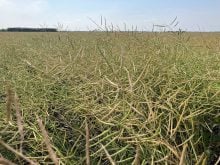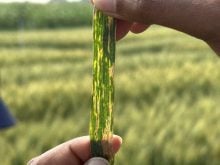Most pesticides work by getting into a cell and disrupting its working parts or pathways. By applying the right chemistry at the right time you can shut down a pathogen’s engine and bring it to a stop.
But despite all the available chemistry, sclerotinia always finds a way to keep driving around untouched.
Mark Belmonte, a professor of biology at the University of Manitoba figures if you can’t use chemistry to gum up its gas lines, jam its gears or puncture its tires, then get into its chips and jigger with its programming.
Read Also

Code cracked on nitrogen-fixing wheat?
U.S. crop breeders have created a wheat variety capable of fixing its own nitrogen rather than relying on fertilizer.
“We’re using what’s called RNA interference,” Belmonte told the Manitoba Agronomists’ Conference earlier this winter. “It interferes with the processing of genetic information within the cell.”
DNA is a giant technical manual. Each page, called a gene, holds the design drafts for the different parts of a bigger machine that we’ll call the cell. Different genes hold the blueprints for different working parts called proteins and within a living system, there are a lot of distinct proteins doing a lot of different jobs. Sclerotinia, makes a set of proteins that it uses to invade, infect, and ultimately kill its plant host.
Each cell has the full manual locked in a vault that we call the nucleus. The assembly line, called a ribosome, is located outside the nucleus. It needs the information so it can make proteins, but it can’t access the manual directly because DNA stays in the vault. The cell must have a copy of the page delivered so the ribosome can read it and get to work.
To do this, the scribes within the nucleus print out a portable copy of the gene. The message leaves the vault and it’s delivered to the assembly line within a strand we call ‘messenger RNA.’ The ribosome reads the page, gathers a set of materials called amino acids and makes them into proteins by hammering them together in the right order.
“If that message is essential for growth or for development then, when we get rid of it, we can knock it down and knock it out,” Belmonte said. “The idea is that we can slow down the growth of the fungus or, ideally, kill the fungus.”
The trick is to intercept the message before the factory gets it, and rewrite it, designing new RNA to mislead the cell and disrupt its ability to produce the proteins it is supposed to make. The first thing Belmonte and his lab had to do was find specific genes that coded for vital proteins.
“We did MRNA sequencing of sclerotinia grown on plates and on tolerant as well as susceptible lines of canola,” he said. “So we generated huge data sets and made an algorithm to identify the best targets.”
These algorithms help to sort through mountains of data and find and identify particular proteins that the fungus can’t work without. Then researchers can find the gene, the page within that technical manual, that holds the blueprint for that protein. Once they know what to look for they can find the RNA sequence that carries the message. What they are trying to do with this RNAi, or RNA interference, technology is to silence that gene by keeping its instructions away from the factory.
“Once we can ensure the molecules we’re designing have no off-target effects we can make them in the lab and spray them onto the fungus,” Belmonte said. “And what’s going to happen is that double-stranded RNA is taken up by the cell.”
This is where the business really starts. The fungus takes the RNAi strands into its cells where it meets an enzyme called “the dicer.”
“And the dicer is going to do exactly what it says,” Belmonte explained. “It’s going to dice up these molecules into the short interfering RNAs and then it’s then going to target a specific Messenger RNA found within the cell.”
At this point a protein called Argonaute binds with it, lops off the redundant “sense strand” and becomes the RNA Induced Silencing Complex or RISC. It’s now a piece of hacked genetic code and the RISC complex takes it, hijacks a strand of real RNA and splices the new instructions into it. When the new strand gets to the factory that one piece of code on it tells the ribosome, ‘You know all that stuff I told to do? Don’t do any of it.’
It silences the gene so the ribosome makes no protein. It’s like telling an automotive assembly line not to worry about lug nuts, just put the wheels on without them. What comes off the line may look like a car but it certainly can’t act like one.
This is a new way of dealing with pathogens because researchers are not actually targeting organisms per se. They are taking aim at a gene and this means they can narrow their focus to very specific targets.
“We can start to move away from some of the traditional broad spectrum fungicides because we know there certainly are beneficial fungi out there,” Belmonte said.
Having said that, there are other pathogens, such as botrytis, that have some genes in common with sclerotinia. The future may see very tightly aimed molecular fungicides controlling a few different pathogenic molds while leaving the beneficial types alone. Plants could even be engineered to produce double stranded RNAs to confound fungal pathogens that are baked right into the mix.
“We’ve developed a topical, next generation molecular fungicide that’s able to protect the plant against disease,” Belmonte said. “The idea is that we can use RNAi technologies as a solution to improve global food security. We know that sclerotinia infects hundreds of different plants globally and causes billions of dollars in damage to growers and that affects their bottom line every year.”















